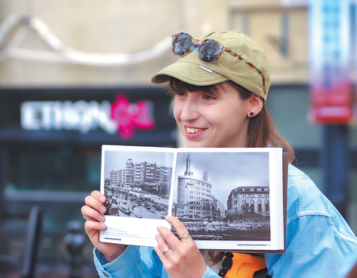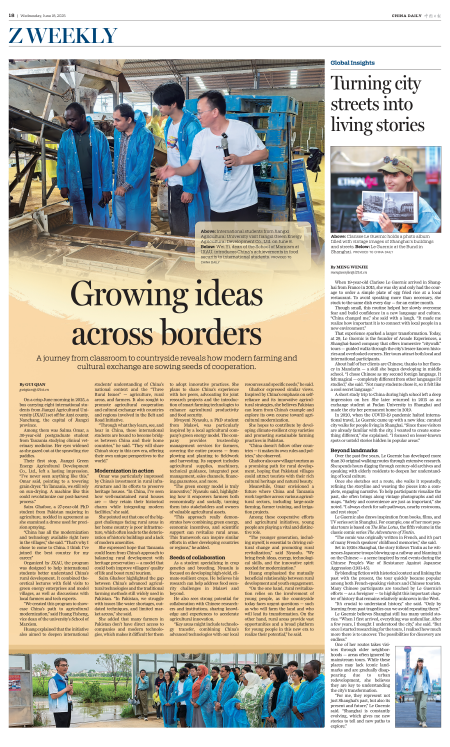
Clarisse Le Guernic holds a photo album filled with vintage images of Shanghai's buildings and streets.

Le Guernic at the Bund in Shanghai.
When 19-year-old Clarisse Le Guernic arrived in Shanghai from France in 2015, she was shy and only had the courage to order a simple plate of egg fried rice at a local restaurant. To avoid speaking more than necessary, she stuck to the same dish every day — for an entire month.
Though small, this routine helped her slowly overcome fear and build confidence in a new language and culture. "China changed me," she said with a laugh. "It made me realize how important it is to connect with local people in a new environment."
That experience sparked a larger transformation. Today, at 29, Le Guernic is the founder of Arcade Experiences, a Shanghai-based company that offers immersive "citywalk "tours — guided walks through the city's lesser-known histories and overlooked corners. Her tours attract both local and international participants.
About half of her clients are Chinese, thanks to her fluency in Mandarin — a skill she began developing in middle school. "I chose Chinese as my second foreign language. It felt magical — completely different from other languages I'd studied," she said. "Not many students chose it, so it felt like a cool secret language."
A short study trip to China during high school left a deep impression on her. She later returned in 2015 as an exchange student at Fudan University in Shanghai and made the city her permanent home in 2019.
In 2020, when the COVID-19 pandemic halted international travel, Le Guernic came up with a new idea: curated city walks for people living in Shanghai. "Since these visitors are already familiar with the city, I wanted to create something different," she explained. "I focused on lesser-known spots or untold stories hidden in popular areas."
Beyond landmarks
Over the past five years, Le Guernic has developed more than 30 original walking routes through extensive research. She spends hours digging through century-old archives and speaking with elderly residents to deepen her understanding of local culture.
Once she sketches out a route, she walks it repeatedly, refining the storyline and weaving the pieces into a complete, engaging narrative. To help participants visualize the past, she often brings along vintage photographs and old maps. "Safety and convenience are just as important," she noted. "I always check for safe pathways, nearby restrooms, and rest stops."
Le Guernic also draws inspiration from books, films, and TV series set in Shanghai. For example, one of her most popular tours is based on The Blue Lotus, the fifth volume in the classic comic series The Adventures of Tintin.
"The comic was originally written in French, and it's part of many French speakers' childhood memories," she said.
Set in 1930s Shanghai, the story follows Tintin as he witnesses Japanese troops blowing up a railway and blaming it on the Chinese — a scene inspired by real events during the Chinese People's War of Resistance Against Japanese Aggression (1931-45).
By blending fiction with historical context and linking the past with the present, the tour quickly became popular among both French-speaking visitors and Chinese tourists. Many Chinese participants are touched by Le Guernic's efforts — as a foreigner — to highlight this important chapter of history that remains relatively unknown in the West.
"It's crucial to understand history," she said. "Only by learning from past tragedies can we avoid repeating them."
Le Guernic believes Shanghai still has many untold stories. "When I first arrived, everything was unfamiliar. After a few years, I thought I understood the city," she said. "But once I started researching for the tours, I realized how much more there is to uncover. The possibilities for discovery are endless."
One of her routes takes visitors through older neighborhoods — areas often ignored by mainstream tours. While these places may lack iconic landmarks and are gradually disappearing due to urban redevelopment, she believes they are key to understanding the city's transformation.
"For me, they represent not just Shanghai's past, but also its present and future," Le Guernic said. "Shanghai is constantly evolving, which gives me new stories to tell and new paths to explore."
mengwenjie@i21st.cn

